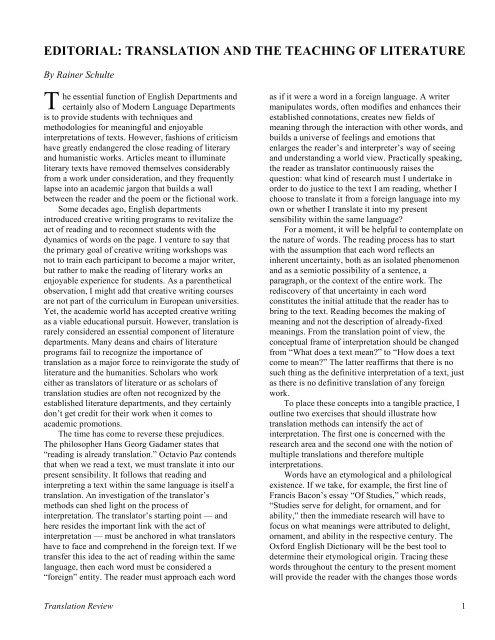Translation Review - The University of Texas at Dallas
Translation Review - The University of Texas at Dallas
Translation Review - The University of Texas at Dallas
Create successful ePaper yourself
Turn your PDF publications into a flip-book with our unique Google optimized e-Paper software.
EDITORIAL: TRANSLATION AND THE TEACHING OF LITERATURE<br />
By Rainer Schulte<br />
T<br />
he essential function <strong>of</strong> English Departments and<br />
certainly also <strong>of</strong> Modern Language Departments<br />
is to provide students with techniques and<br />
methodologies for meaningful and enjoyable<br />
interpret<strong>at</strong>ions <strong>of</strong> texts. However, fashions <strong>of</strong> criticism<br />
have gre<strong>at</strong>ly endangered the close reading <strong>of</strong> literary<br />
and humanistic works. Articles meant to illumin<strong>at</strong>e<br />
literary texts have removed themselves considerably<br />
from a work under consider<strong>at</strong>ion, and they frequently<br />
lapse into an academic jargon th<strong>at</strong> builds a wall<br />
between the reader and the poem or the fictional work.<br />
Some decades ago, English departments<br />
introduced cre<strong>at</strong>ive writing programs to revitalize the<br />
act <strong>of</strong> reading and to reconnect students with the<br />
dynamics <strong>of</strong> words on the page. I venture to say th<strong>at</strong><br />
the primary goal <strong>of</strong> cre<strong>at</strong>ive writing workshops was<br />
not to train each participant to become a major writer,<br />
but r<strong>at</strong>her to make the reading <strong>of</strong> literary works an<br />
enjoyable experience for students. As a parenthetical<br />
observ<strong>at</strong>ion, I might add th<strong>at</strong> cre<strong>at</strong>ive writing courses<br />
are not part <strong>of</strong> the curriculum in European universities.<br />
Yet, the academic world has accepted cre<strong>at</strong>ive writing<br />
as a viable educ<strong>at</strong>ional pursuit. However, transl<strong>at</strong>ion is<br />
rarely considered an essential component <strong>of</strong> liter<strong>at</strong>ure<br />
departments. Many deans and chairs <strong>of</strong> liter<strong>at</strong>ure<br />
programs fail to recognize the importance <strong>of</strong><br />
transl<strong>at</strong>ion as a major force to reinvigor<strong>at</strong>e the study <strong>of</strong><br />
liter<strong>at</strong>ure and the humanities. Scholars who work<br />
either as transl<strong>at</strong>ors <strong>of</strong> liter<strong>at</strong>ure or as scholars <strong>of</strong><br />
transl<strong>at</strong>ion studies are <strong>of</strong>ten not recognized by the<br />
established liter<strong>at</strong>ure departments, and they certainly<br />
don’t get credit for their work when it comes to<br />
academic promotions.<br />
<strong>The</strong> time has come to reverse these prejudices.<br />
<strong>The</strong> philosopher Hans Georg Gadamer st<strong>at</strong>es th<strong>at</strong><br />
“reading is already transl<strong>at</strong>ion.” Octavio Paz contends<br />
th<strong>at</strong> when we read a text, we must transl<strong>at</strong>e it into our<br />
present sensibility. It follows th<strong>at</strong> reading and<br />
interpreting a text within the same language is itself a<br />
transl<strong>at</strong>ion. An investig<strong>at</strong>ion <strong>of</strong> the transl<strong>at</strong>or’s<br />
methods can shed light on the process <strong>of</strong><br />
interpret<strong>at</strong>ion. <strong>The</strong> transl<strong>at</strong>or’s starting point — and<br />
here resides the important link with the act <strong>of</strong><br />
interpret<strong>at</strong>ion — must be anchored in wh<strong>at</strong> transl<strong>at</strong>ors<br />
have to face and comprehend in the foreign text. If we<br />
transfer this idea to the act <strong>of</strong> reading within the same<br />
language, then each word must be considered a<br />
“foreign” entity. <strong>The</strong> reader must approach each word<br />
as if it were a word in a foreign language. A writer<br />
manipul<strong>at</strong>es words, <strong>of</strong>ten modifies and enhances their<br />
established connot<strong>at</strong>ions, cre<strong>at</strong>es new fields <strong>of</strong><br />
meaning through the interaction with other words, and<br />
builds a universe <strong>of</strong> feelings and emotions th<strong>at</strong><br />
enlarges the reader’s and interpreter’s way <strong>of</strong> seeing<br />
and understanding a world view. Practically speaking,<br />
the reader as transl<strong>at</strong>or continuously raises the<br />
question: wh<strong>at</strong> kind <strong>of</strong> research must I undertake in<br />
order to do justice to the text I am reading, whether I<br />
choose to transl<strong>at</strong>e it from a foreign language into my<br />
own or whether I transl<strong>at</strong>e it into my present<br />
sensibility within the same language<br />
For a moment, it will be helpful to contempl<strong>at</strong>e on<br />
the n<strong>at</strong>ure <strong>of</strong> words. <strong>The</strong> reading process has to start<br />
with the assumption th<strong>at</strong> each word reflects an<br />
inherent uncertainty, both as an isol<strong>at</strong>ed phenomenon<br />
and as a semiotic possibility <strong>of</strong> a sentence, a<br />
paragraph, or the context <strong>of</strong> the entire work. <strong>The</strong><br />
rediscovery <strong>of</strong> th<strong>at</strong> uncertainty in each word<br />
constitutes the initial <strong>at</strong>titude th<strong>at</strong> the reader has to<br />
bring to the text. Reading becomes the making <strong>of</strong><br />
meaning and not the description <strong>of</strong> already-fixed<br />
meanings. From the transl<strong>at</strong>ion point <strong>of</strong> view, the<br />
conceptual frame <strong>of</strong> interpret<strong>at</strong>ion should be changed<br />
from “Wh<strong>at</strong> does a text mean” to “How does a text<br />
come to mean” <strong>The</strong> l<strong>at</strong>ter reaffirms th<strong>at</strong> there is no<br />
such thing as the definitive interpret<strong>at</strong>ion <strong>of</strong> a text, just<br />
as there is no definitive transl<strong>at</strong>ion <strong>of</strong> any foreign<br />
work.<br />
To place these concepts into a tangible practice, I<br />
outline two exercises th<strong>at</strong> should illustr<strong>at</strong>e how<br />
transl<strong>at</strong>ion methods can intensify the act <strong>of</strong><br />
interpret<strong>at</strong>ion. <strong>The</strong> first one is concerned with the<br />
research area and the second one with the notion <strong>of</strong><br />
multiple transl<strong>at</strong>ions and therefore multiple<br />
interpret<strong>at</strong>ions.<br />
Words have an etymological and a philological<br />
existence. If we take, for example, the first line <strong>of</strong><br />
Francis Bacon’s essay “Of Studies,” which reads,<br />
“Studies serve for delight, for ornament, and for<br />
ability,” then the immedi<strong>at</strong>e research will have to<br />
focus on wh<strong>at</strong> meanings were <strong>at</strong>tributed to delight,<br />
ornament, and ability in the respective century. <strong>The</strong><br />
Oxford English Dictionary will be the best tool to<br />
determine their etymological origin. Tracing these<br />
words throughout the century to the present moment<br />
will provide the reader with the changes those words<br />
<strong>Transl<strong>at</strong>ion</strong> <strong>Review</strong> 1

















